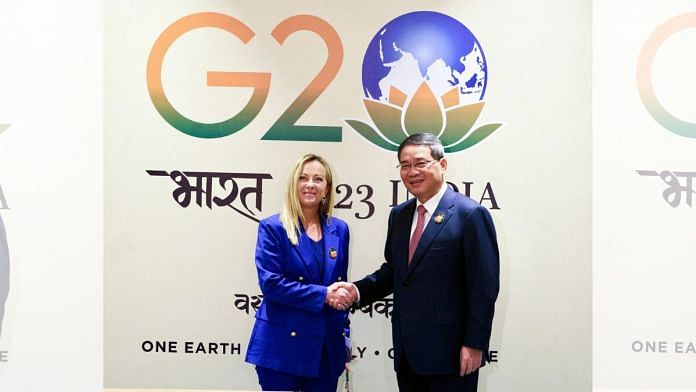New Delhi: On 4 December, the Italian government officially gave notice to China about Rome withdrawing from the Belt and Road Initiative (BRI) — Beijing’s flagship infrastructure initiative. Italy was the only member country of the BRI from the Group of Seven (G7) advanced major economies.
Italy, the third-largest economy in the European Union (EU) joined the BRI in 2019. According to the memorandum of participation signed in March 2019 between the two governments for five years (till 2024), Italy had to give notice of its intention to not renew the participation at least three months before the expiry of the agreement. Otherwise the agreement would automatically renew for a further five years.
While there has been no official communication from the government of Italy on its withdrawal, the Italian newspaper Corriere della Sera reported the issue earlier this week before being picked up and widely reported by Western media organisations.
Speaking at a regular briefing Thursday, Chinese ministry of foreign affairs spokesperson Wang Wenbin said, without directly naming Italy, “China firmly opposes attempts to smear and sabotage Belt and Road cooperation or stoke bloc confrontation and division.”
More than 150 countries, many of them developing and emerging economies, are part of President Xi Jinping’s BRI — touted as the “project of the century” — which envisages new trade routes connecting China with the rest of the world and includes construction of ports, roads, railways, airports and other infrastructure.
When Italy joined the BRI in 2019, the country was led by Giuseppe Conte — a populist leader representing the 5 Stars Movement (5SM) party — in coalition with Matteo Salvini’s Lega Nord.
Months before signing up to the BRI, Italy tumbled into its third recession in a decade. In the backdrop of a recession, the Italian government signed agreements promising up to €20 billion worth of investments into ports, agriculture, e-commerce, satellites, natural gas and steel with Beijing. The BRI potentially allowed Italy access to Chinese investments, while also gaining access to the market for their exports.
However, President of Italy Sergio Matarella in 2019 publicly cautioned that the deal must work for both countries. According to media reports, Matarella said, “The New Silk Road [BRI] must be a two-way street to share not only goods but also talent, ideas, knowledge, forward-looking solutions to common problems and projects for the future.”
Also read: China now investing sovereign funds in strategic assets abroad. And escaping West’s scrutiny
Did Italy benefit?
At the height of its recession, a promise of investments seemed to motivate Rome to partner with China, however since Giorgia Meloni came to power at Chigi Palace, she indicated in 2022 that joining the BRI was a “big mistake”.
In July 2023, Guido Crosetto, the Italian minister of defence reportedly called the decision to join the BRI as “improvised and atrocious”, which increased Chinese exports to Italy with little reciprocal effect for Italian exports to China, Crosetto told Italian newspaper Corriere della Sera.
In 2019, Italy’s total exports to China was worth €13.4 billion, which increased to €16 billion by 2022 as per data from UN Comtrade. Whereas China’s exports in 2022 were worth €56 billion, a significant increase from €32.8 billion in 2019.
In comparison, Germany exported €105 billion worth of goods to China in 2022, an increase from €100 billion worth of exports in 2019 according to UN Comtrade data, despite not being a member of the BRI.
The promised foreign direct investment into Italy from China never arrived. From $650 million in 2019, it fell to $20 million in 2020, with a slight increase in 2021 to $33 million, as reported by the Italian Institute for International Political Studies (ISPI).
In comparison, Germany and France received $1.9 billion and $1.8 billion in FDI from China, respectively in 2020, as reported by the South China Morning Post (SCMP). The UK, France, Germany, the Netherlands and Finland are the biggest recipients of Chinese FDI, despite not being a member of the BRI, SCMP notes.
In September during the G20 summit in New Delhi, it was widely reported by the media that Meloni had informed Chinese Premier Li Qiang of Italy’s intention to quit the BRI. An Italian government readout of the meeting “confirmed the common intention to consolidate and deepen dialogue between Rome and Beijing on the major bilateral and international issues.” It made no mention of Italy’s membership in the BRI.
Italy will also chair the G7 in 2024.
The evolution of BRI
Since 2018, the BRI has evolved from infrastructure investment to becoming a lender for supporting economies in financial distress as reported by ThePrint earlier. Since October 2016, there has been a major rethink within the Chinese polity on its overseas investment portfolio, AidData, a research lab at the college of William and Mary in the US found in a report published 6 November.
While Beijing has outspent its closest competitor — the US — for international aid 2:1 between 2014 and 2021 as reported by AidData, it has recently faced competition from the G7. At the sidelines of the G20 summit in September, the G7 economies, including Italy, announced the India-Middle East-Europe Economic Corridor (IMEEC) and the Lobito Corridor in Africa.
The IMEEC, to which Italy is a signatory, would consist of two economic corridors — the Eastern corridor connecting India to West Asia/Middle East and the Northern corridor connecting West Asia/Middle East with Europe, as reported by ThePrint earlier.
The corridor, launched by India, the US, the UAE, Saudi Arabia, European Union (EU), Italy, France and Germany, is viewed as a counter to the BRI. This comes amid the BRI’s reputational damage over China’s lending practices.
AidData found that Beijing’s reputation plummeted from 56 percent in 2019 to 40 percent in 2021 in the low- and middle-income countries.
(Edited by Zinnia Ray Chaudhuri)
Also read: ‘Asian century’: China’s new foreign policy prioritises neighbours, India finds mention in footnote



